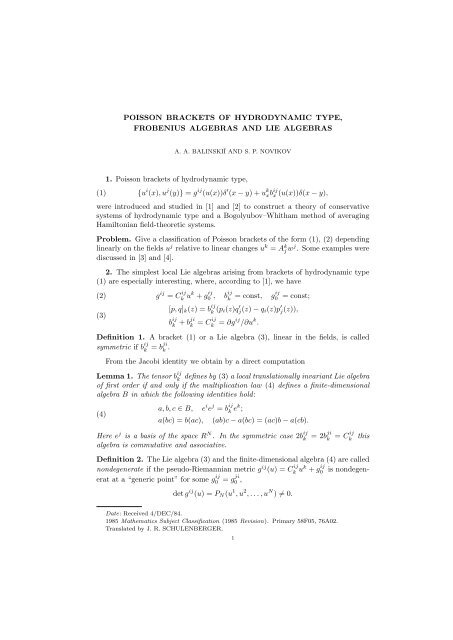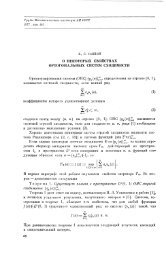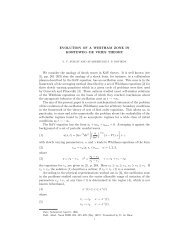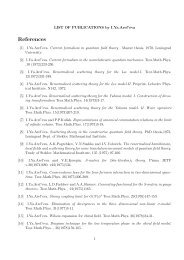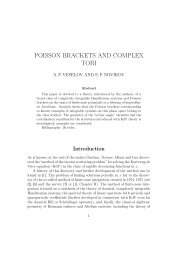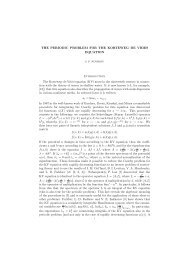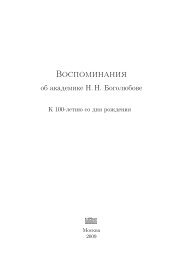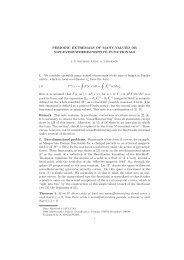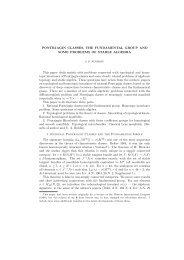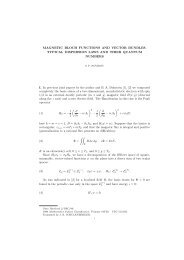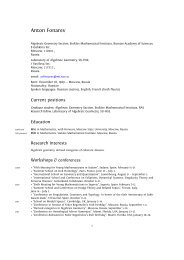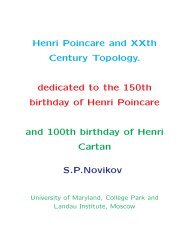Poisson brackets of hydrodynamic type, Frobenius algebras and Lie ...
Poisson brackets of hydrodynamic type, Frobenius algebras and Lie ...
Poisson brackets of hydrodynamic type, Frobenius algebras and Lie ...
You also want an ePaper? Increase the reach of your titles
YUMPU automatically turns print PDFs into web optimized ePapers that Google loves.
POISSON BRACKETS OF HYDRODYNAMIC TYPE,<br />
FROBENIUS ALGEBRAS AND LIE ALGEBRAS<br />
A. A. BALINSKIĬ AND S. P. NOVIKOV<br />
1. <strong>Poisson</strong> <strong>brackets</strong> <strong>of</strong> <strong>hydrodynamic</strong> <strong>type</strong>,<br />
(1) {u i (x), u j (y)} = g ij (u(x))δ ′ (x − y) + u k xb ij<br />
x (u(x))δ(x − y),<br />
were introduced <strong>and</strong> studied in [1] <strong>and</strong> [2] to construct a theory <strong>of</strong> conservative<br />
systems <strong>of</strong> <strong>hydrodynamic</strong> <strong>type</strong> <strong>and</strong> a Bogolyubov–Whitham method <strong>of</strong> averaging<br />
Hamiltonian field-theoretic systems.<br />
Problem. Give a classification <strong>of</strong> <strong>Poisson</strong> <strong>brackets</strong> <strong>of</strong> the form (1), (2) depending<br />
linearly on the fields u j relative to linear changes u k = A k j wj . Some examples were<br />
discussed in [3] <strong>and</strong> [4].<br />
2. The simplest local <strong>Lie</strong> <strong>algebras</strong> arising from <strong>brackets</strong> <strong>of</strong> <strong>hydrodynamic</strong> <strong>type</strong><br />
(1) are especially interesting, where, according to [1], we have<br />
(2) g ij = C ij<br />
k uk + g ij<br />
0 , bij k<br />
= const, gij 0 = const;<br />
[p, q] k (z) = b ij<br />
k (p i(z)q j(z) ′ − q i (z)p ′ j(z)),<br />
(3)<br />
b ij<br />
k + bji k<br />
= Cij k = ∂gij /∂u k .<br />
Definition 1. A bracket (1) or a <strong>Lie</strong> algebra (3), linear in the fields, is called<br />
symmetric if b ij<br />
k<br />
= bji k .<br />
From the Jacobi identity we obtain by a direct computation<br />
Lemma 1. The tensor b ij<br />
k<br />
defines by (3) a local translationally invariant <strong>Lie</strong> algebra<br />
<strong>of</strong> first order if <strong>and</strong> only if the multiplication law (4) defines a finite-dimensional<br />
algebra B in which the following identities hold:<br />
(4)<br />
a, b, c ∈ B, e i e j = b ij<br />
k ek ;<br />
a(bc) = b(ac), (ab)c − a(bc) = (ac)b − a(cb).<br />
Here e j is a basis <strong>of</strong> the space R N . In the symmetric case 2b ij<br />
k<br />
algebra is commutative <strong>and</strong> associative.<br />
= 2bji k<br />
= Cij k<br />
Definition 2. The <strong>Lie</strong> algebra (3) <strong>and</strong> the finite-dimensional algebra (4) are called<br />
nondegenerate if the pseudo-Riemannian metric g ij (u) = C ij<br />
k uk + g ij<br />
0 is nondegenerat<br />
at a “generic point” for some g ij<br />
0 = gji 0 ,<br />
det g ij (u) = P N (u 1 , u 2 , . . . , u N ) ≠ 0.<br />
this<br />
Date: Received 4/DEC/84.<br />
1985 Mathematics Subject Classification (1985 Revision). Primary 58F05, 76A02.<br />
Translated by J. R. SCHULENBERGER.<br />
1
2 A. A. BALINSKIĬ AND S. P. NOVIKOV<br />
We recall that a commutative associative algebra is called a <strong>Frobenius</strong> algebra<br />
if there is given a nondegenerate inner product 〈·, ·〉 such that<br />
(5) 〈e i e j , e k 〉 = 〈e i , e j e k 〉.<br />
This means that the regular representation is “<strong>Frobenius</strong>”, i.e., the operators<br />
<strong>of</strong> multiplication by any element are adjoint in this inner product. The necessary<br />
<strong>and</strong> sufficient conndition that an algebra with identity be <strong>Frobenius</strong> in our terms<br />
is that 2b ij<br />
k uk = C ij<br />
k uk be nondegenerate at a generic point (conversely, under this<br />
condition the algebra B has an identity).<br />
<strong>Frobenius</strong> structures are nondegenerate inner products with properties (5). They<br />
all reduce to C ij<br />
k uk at some point u = u 0 if det(C ij<br />
k uk ) ≠ 0.<br />
Proposition 1. Classification <strong>of</strong> infinite-dimensional, nondegenerate, local, translationally<br />
invariant, symmetric <strong>Lie</strong> <strong>algebras</strong> <strong>of</strong> first order relative to linear changes<br />
p k = A j k ˜p j in the space <strong>of</strong> values <strong>of</strong> the fields is completely equivalent to the classification<br />
<strong>of</strong> finite-dimensional, commutative, associative <strong>algebras</strong> over R which admit<br />
the structure <strong>of</strong> a <strong>Frobenius</strong> algebra (possibly, without identity).<br />
Any nondegenerate metric (2) is reduced by the changes u i = ū i + u i 0 to a purely<br />
linear metric ḡ ij = γ ij (u) = C ij<br />
k uk , ḡ ij<br />
0 = 0, if<br />
2b ij<br />
j<br />
= Cij k ,<br />
det(Cij k uk ) ≠ 0.<br />
3. Since according to [1] the metric g ij (u) = C k ij uk must have zero curvature,<br />
we appeal to changes u(v), which are now nonlinear, where the metric in the new<br />
coordinates (v 1 , . . . , v N ) is constant:<br />
g ij (u(v)) = g αβ<br />
0 (∂ui /∂v α )(∂u j /∂v β ), g αβ<br />
0 = const.<br />
We consider the purely quadratic changes<br />
(6) u i = 1 2 F i αβv α v β .<br />
We have<br />
Theorem 1. For a change (6) to reduce the metric <strong>of</strong> zero curvature g ij = C ij<br />
k uk<br />
such that b ij<br />
k<br />
= Γj sk gsi = const, det(C ij<br />
k uk ) ≠ 0, to constant form it is necessary<br />
<strong>and</strong> sufficient that the following conditions hold:<br />
a) b ij<br />
k<br />
= bji k ;<br />
b) F <strong>and</strong> g ij<br />
0 determine a <strong>Frobenius</strong> representation <strong>of</strong> the algebra (4), where the<br />
Fαγ i give a representation <strong>of</strong> the basis e i <strong>of</strong> the algebra in the form <strong>of</strong> linear operators<br />
in (v)-space which are self adjoint in this inner product, so that<br />
e i → (F i ) α β = g αγ<br />
0 F i γβ, F i F j = C ij<br />
k F k /2,<br />
det(F i αβv β ) ≠ 0 at a generic point (v 1 , . . . , v N ).<br />
Summarizing previous observations, the pro<strong>of</strong> <strong>of</strong> Theorem 1 essentially based<br />
on a simple tensor computation with the substitution (6), using the fact that the<br />
connection ˜Γ α βγ<br />
≡ 0 in the new coordinates v.<br />
4. In the general nonsymmetric case (3), where the finite-dimensional algebra<br />
B has the form (4), the classification is complicated. If R b (a) = ab = L a (b), then<br />
from (4) we have<br />
(7) [L a , L b ] = 0, [R a , R b ] = R [a,b] = R ab−ba .
POISSON BRACKETS OF HYDRODYNAMIC TYPE, FROBENIUS ALGEBRAS... 3<br />
If the algebra B is associative, then it possesses a left ideal I ⊂ B such that<br />
(8) IB = 0, [B, B] ⊂ I.<br />
As a more general case, we consider <strong>algebras</strong> (4), (7) with an ideal I ⊂ B such<br />
that II = 0. Then the quotient A = B/I is an algebra <strong>of</strong> the <strong>type</strong> (4), (7), <strong>and</strong><br />
the theory <strong>of</strong> extensions arises. Suppose, conversely, that there is given a two-sided<br />
A-module I such that for any triple <strong>of</strong> elements a, b ∈ A, d ∈ I properties (4) <strong>and</strong><br />
(7) hold, where IA ⊂ I, AI ⊂ I.<br />
Proposition 2. Any 2-cochain d(a, b) ∈ I linear in a <strong>and</strong> b determines a new<br />
algebra B with ideal I, I 2 = 0, <strong>and</strong> identities (4) <strong>and</strong> (7) if <strong>and</strong> only if<br />
(9)<br />
δd(a, b, c) − δd(a, c, b) = ∆ 1 d(a, b, c) = 0,<br />
δd(a, b, c) − δd(b, a, c) − d(ab − ba, c) − [d(a, b) − d(b, a)]c = ∆ 2 d(a, b, c) = 0,<br />
where δd(a, b, c) = d(a, bc) − d(ab, c) + ad(b, c) − d(a, b)c.<br />
Extensions with cocycles d 1 <strong>and</strong> d 2 are equivalent if d 1 <strong>and</strong> d 2 are cohomologous:<br />
(10) d 1 = d 2 + δh(a, b), δh(a, b) = h(ab) + ah(b) − h(a)b.<br />
For <strong>algebras</strong> A with identities (4) <strong>and</strong> (7) <strong>and</strong> corresponding A-modules I we<br />
have<br />
∆ 1 δ ≡ 0, ∆ 2 δ ≡ 0.<br />
The cocycles (9) with the equivalence (10) form the group <strong>of</strong> algebra extensions <strong>of</strong><br />
(4), (7): d ∈ HΦ 2 (A, I).<br />
From Proposition 2 there follows<br />
Corollary 1. If the algebra A is commutative <strong>and</strong> associative <strong>and</strong> the right action<br />
<strong>of</strong> A on I is trivial, IA ≡ 0, then the cochain d(a, b) determines an algebra B <strong>of</strong><br />
<strong>type</strong> (4), (7) if <strong>and</strong> only if the 3-cochain δd is symmetric relative to all permutations<br />
<strong>of</strong> a, b, c.<br />
Theorem 2. Any associative algebra B <strong>of</strong> <strong>type</strong> (4), (7) can be obtained by extension<br />
<strong>of</strong> a commutative algebra where IA ≡ 0 according to (3). In the nondegenerate case<br />
the substitution (11) reduces the metric g ij (u) = (b ij<br />
k +bji k )uk +g ij<br />
0 to constant form<br />
ḡ αβ<br />
0 (it is here assumed with no loss <strong>of</strong> generality that g ij<br />
0 is nondegenerate <strong>and</strong><br />
ḡ ij<br />
0 = gij 0 ):<br />
(11)<br />
u q = w q + 1 2 F q αβ wα w β ,<br />
α, β, q, i = 1, 2, . . . , n, F γ αβ = F γ βα ,<br />
F αγ<br />
β<br />
The following relations hold:<br />
= ḡ κα<br />
0 F γ αβ = (F γ ) α β.<br />
F γ F δ = F δ F γ = b γδ<br />
κ F κ = b δγ<br />
κ F κ .<br />
Here the vectors f 1 , . . . , f n are the basis unit vectors <strong>of</strong> the coordinates w 1 , . . . , w n<br />
in the notation (11). They generate a left regular representation <strong>of</strong> the algebra B<br />
ḡ pq<br />
0 = 〈f p , f q 〉 = g pq<br />
0 , F α f p = b αp<br />
q f q .<br />
The substitution (11) is nondegenerate at a generic point (w 1 , . . . , w n ) if <strong>and</strong> only<br />
if the metric g ij (u) is nondegenerate.
4 A. A. BALINSKIĬ AND S. P. NOVIKOV<br />
5. <strong>Lie</strong> <strong>algebras</strong> (3) sometimes possess central R-extensions by means <strong>of</strong> the<br />
simplest cocycles <strong>of</strong> the <strong>type</strong> <strong>of</strong> the Gel’f<strong>and</strong>–Fuks cocycle for an algebra <strong>of</strong> vector<br />
fields [5]. The 2-cocycles <strong>of</strong> order τ are given by the formula<br />
∫<br />
(12) γ τ (p, q) = γ ij q j dx = −γ τ (q, p).<br />
τ p (τ)<br />
i<br />
The cocycles (12) generate additions to the <strong>Poisson</strong> <strong>brackets</strong> (1), (3) <strong>of</strong> the form<br />
γ ij<br />
τ δ (τ) (x − y).<br />
Such cocycles are possible for τ 3. Formula (12) defines a cocycle on the <strong>Lie</strong><br />
algebra (3) <strong>and</strong> an addition to the bracket (1) without violating the Jacobi identity<br />
if <strong>and</strong> only if<br />
(13)<br />
τ = 0: p ijk = t ijk − t kji , p σ(ijk) = (−1) σ p ijk ,<br />
τ = 1: t ijk = t ikj ,<br />
τ = 2: t ijk = −t ikj , t ijk + t kij + t jki = 0,<br />
τ = 3: t ijk = t σ(ijk) ,<br />
where t αβγ = b αβ<br />
k<br />
γkδ , σ is any permutation, <strong>and</strong> (−1) σ is its sign. We have<br />
Proposition 3. The forms δτ ij (u) = (b ij<br />
k + (−1)τ+1 b ji<br />
k )uk are cocycles <strong>and</strong> define a<br />
central extension <strong>of</strong> the <strong>Lie</strong> algebra (3) for all (u 1 , . . . , u n ) if <strong>and</strong> only if the algebra<br />
B possesses the following properties:<br />
τ = 0: in the algebra the identity [ab + ba, c]/2 = (ca)b − c(ab) holds;<br />
τ = 1: the form δ ij<br />
1 (u) always defines a cocycle on the <strong>Lie</strong> algebra which is a<br />
coboundary;<br />
τ = 2: the algebra B is associative;<br />
τ = 3: the algebra B is such that a([b, c]) = −[b, c]a, where [b, c] = bc − cb,<br />
a, b, c ∈ B.<br />
Proposition 4. If there exists a nondegenerate form γτ<br />
ij<br />
“exterior” cocycle <strong>of</strong> order τ on the <strong>Lie</strong> algebra (3), then<br />
= (−1) τ+1 γ ji<br />
τ<br />
defining an<br />
a) τ = 1: If the algebra B is associative, then the metric g ij (u) = δ ij<br />
1<br />
reduces to constant form by the substitution (11). The transformations γ ij<br />
γ ij<br />
1 + δij 1 (u 0) replace the cocycle by a homologous cocycle.<br />
b) τ = 2: Such a nondegenerate form γ ij<br />
(u) + γij 1<br />
1 →<br />
2 is possessed by a <strong>Lie</strong> algebra with<br />
associative algebra B <strong>and</strong> ideal I ⊂ B, where [B, B] ⊂ I, IB = 0, the quotient<br />
A = B/I is a Frobenins algebra with identity. Here A = I acts on I by the<br />
left regular representation <strong>and</strong> the cocycle d ∈ H 2 (A, I) giving the extensions is<br />
arbitrary (the converse has not been proved!).<br />
c) τ = 3: The algebra B is a <strong>Frobenius</strong> algebra; γ ij<br />
3 = δij 3 (u 0) if the algebra has<br />
an identity.<br />
Example. For the <strong>Poisson</strong> <strong>brackets</strong> <strong>of</strong> one-dimensional <strong>hydrodynamic</strong>s we have<br />
p = u 1 , ρ = u 2 , s = u 3 <strong>and</strong> b 11<br />
1 = b 12<br />
2 = b 13<br />
3 = 1 (the remaining b ij<br />
k<br />
= 0). The<br />
algebra B is such that any symmetric form γ ij<br />
1 defines a cocycle on the <strong>Lie</strong> algebra<br />
<strong>of</strong> order τ = 1. The cohomology classes <strong>of</strong> such cocycles correspond to arbitrary<br />
symmetric 2 × 2 matrices—restrictions <strong>of</strong> the form γ ij<br />
1 to the space <strong>of</strong> variables<br />
(u 2 , u 3 ). The corresponding central extensions (14) <strong>of</strong> the <strong>Lie</strong> algebra for τ = 1 are<br />
nonequivalent.
POISSON BRACKETS OF HYDRODYNAMIC TYPE, FROBENIUS ALGEBRAS... 5<br />
For vector-valued functions periodic in x, by passing to an expansion in Fourier<br />
series, we obtain a basis (L i n, z) with the relations<br />
(14)<br />
[L i n, L j m] = (mb ij<br />
k − nbji k )Lk m+n + ∑ τ<br />
[z, L i n] = 0,<br />
γ ij<br />
τ<br />
= (−1) τ+1 γ ji<br />
τ ,<br />
γ ij<br />
τ n τ δ m+n,0 · z,<br />
The authors thank I. R. Shafarevich, È. B. Vinberg, <strong>and</strong> D. B. Fuks for valuable<br />
consultations.<br />
References<br />
[1] B. A. Dubrovin <strong>and</strong> S. P. Novikov, Dokl. Akad. Nauk SSSR 270 (1983), 781–785; English<br />
transl. in Soviet Math. Dokl. 27 (1983).<br />
[2] , Dokl. Akad. Nauk SSSR 279 (1984), 294–297; English transl. in Soviet Math. Dokl.<br />
30 (1984).<br />
[3] S. P. Novikov, Uspekhi Mat. Nauk 37 (1982), no. 5(227), 3–49; English transl. in Russian<br />
Math. Surveys 37 (1982).<br />
[4] I. M. Gel’f<strong>and</strong> <strong>and</strong> I. Ya. Dorfman, Funktsional. Anal. i Prilozhen. 15 (1981), no. 3, 23–40;<br />
English transl. in Functional Anal. Appl. 15 (1981).<br />
[5] I. M. Gel’f<strong>and</strong> <strong>and</strong> D. B. Fuks, Funktsional. Anal, i Prilozhen. 2 (1968), no. 4, 92–93; English<br />
transl. in Functional Anal. Appl. 2 (1968).<br />
L<strong>and</strong>au Institute <strong>of</strong> Theoretical Physics, Academy <strong>of</strong> Sciences <strong>of</strong> the USSR, Chernogolovka,<br />
Moscow District


